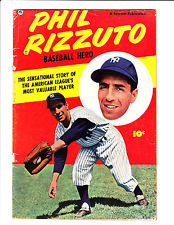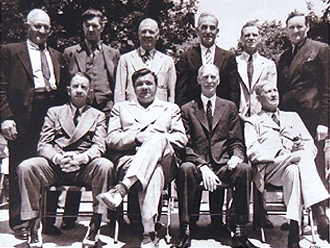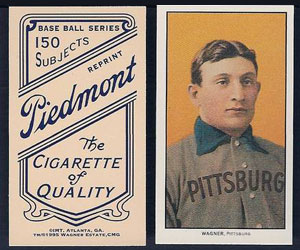
Snoopy is the shortstop/groundskeeper for Charlie Brown’s baseball team. The all-time best groundskeeper is of course KC’s George Toma. As for shortstop, see below.
My Favorite Shortstop (At Age 10): When I was in cub scouts, I played shortstop on the softball team for our pack – doing my best to emulate my idol Phil “Scooter” Rizzuto. Not only did he play for the Yankees, the parent team for our Kansas City Blues, but he was only 5’6” and so gave me hope as a fellow short person. Rizzuto had played for the Blues in 1939 and 1940 before heading to the Yankees in 1941. By the time I knew about Rizzuto, he had established himself as a key part of the Yankee teams that won 10 pennants and 7 World Series during his 13-year career. In 1950, he was the MVP of the AL, and I bought a comic book that winter that covered his big season. I still remember the panel that showed him getting his 200th hit, “a typical Rizzuto bunt.” Alas, when I moved on to 3&2 little league ball I found I did not have a shortstop arm and moved over to 2B to be a good field-no hit utility player in a very short career.
Rizzuto went on the broadcasting fame, some 40 years on radio and TV for the Yankees (“Holy Cow!” was his catchphrase). His stats did not initially get him into the Hall of Fame – he missed three prime years for service in WWII – but in 1994 the Veterans Committee voted him in. Good for them.
As for my old comic book, it is long gone, but the magic of Google got me an image of the cover.

Ian’s Favorite Shortstop (At Age 10): Grandson Ian has not settled into a fixed position yet in little league, but his favorite player is Royals’ shortstop Alcides Escobar. When Ian needed a new jersey to wear to the ALCS last fall, he of course chose Escobar. Here he is at Royals FanFest last month:
 |
WAR and All-Time Players: My last post buried you with WAR info, and here is a little more. As Ian and grandpa Lonnie configure an all-time lineup, we must compare players from many eras. The sabermetricians have utilized adjustments to reflect different times, but some of the metrics for calculating career WAR are not always available. For example, FanGraphs WAR considers 15 skills as part of its fielding component, but only about half of those were measured in earlier eras. So some educated guesswork is involved when you compare say a shortstop from the first of the 20th century (Honus Wagner) and one from the end the century (Cal Ripken). But let’s try anyway.
Best All-Time Shortstop: When the baseball writers picked the 1936 inaugural class for the Hall of Fame, they chose two outfielders (Ty Cobb and Babe Ruth), two pitchers (Walter Johnson and Christy Mathewson) and only one infielder, shortstop Honus Wagner. So you know Wagner must be special. And he was: playing from 1897 to 1917, mostly with the Pittsburg Pirates, Wagner is the career shortstop leader in batting (.327), RBI’s (1,732), runs (1,736) and stolen bases (722). He hit over .300 in 15 consecutive seasons, winning 8 NL batting titles. He was also considered an excellent fielder. His WAR of 138 is by far the highest for a shortstop. So Ian and I agree – Honus Wagner is the best all-time shortstop.

The photo above was taken on June 12, 1939, when the first four classes of the Hall of Fame were inducted (1936-1939). There was no ceremony for the first three classes because construction was not completed at Cooperstown until 1939. The photo includes all then-living Hall of Famers except Ty Cobb – the speedy base stealer arrived late for the ceremony. Front Row: Eddie Collins, Babe Ruth, Connie Mack, Cy Young; Back Row: Honus Wagner, Grover Cleveland Alexander, Tris Speaker, Napoleon Lajoie, George Sisler, Walter Johnson.
Other Great Shortstops: With a WAR of 92.5, Cal Ripken makes a strong case for second place. He is third in hits at 3,184 (Jeter – 3,465, Wagner – 3,415); second in home runs at 431 (arguably first since Ernie Banks – 512 HR – played more games at 1B than SS); and second in RBI’s with 1,695 (Wagner had 1,732). Of course, Ripken’s most well-known stat is not a metric in calculating WAR: he played in 2,632 consecutive games, far surpassing Lou Gehrig’s “unbreakable” streak of 2,130.
A good argument can be made for Derek Jeter to challenge Ripken. Jeter retired after the 2014 season and will be a Hall of Fame shoo-in. Jeter had excellent career numbers: .307 BA; 3,465 hits (tops at shortstop and 6th overall); 1,311RBI’s; 544 doubles; 260 HR’s; and 358 stolen bases. Neither was a great fielder, although Ripken had a couple of Gold Gloves. Ripken leads in WAR, 92.5 to 71.7, but Jeter counters this with some important stats not reflected in WAR, the post-season – he had 200 hits and 302 total bases to top all hitters (runner-up numbers are 128 and 223, a huge margin).
Other leading Hall of Famers at shortstop are grouped between 60 to 75 on WAR: Robin Yount, Ozzie Smith, Luke Appling, Arky Vaughn, Joe Cronin, Barry Larkin and Lou Boudreau. Ernie Banks won his two MVP’s early in his career while playing shortstop, but played more games at 1B.
Alex Rodriguez, not yet retired, has sufficient WAR to be in the mix, but A-Rod played more games at positions other than his natural shortstop. When he was traded to the Yankees in 2004, he agreed to play 3B in deference to the incumbent SS, Derek Jeter. His Hall of Fame future is clouded with steroids and a full-year suspension.
Roger Angell, Earl Weaver and Cal Ripken: This anecdote is about a dugout conversation that Roger Angell transcribed for all of us. In 1982, Angell and some other sportswriters visited before a game at Fenway with Orioles’ manager Earl Weaver. He told them that the coaches had been working with rookie Cal Ripken who was making the difficult transition from third base to shortstop. Two very different positions – the third baseman must take a half step forward on the pitch to be ready for the bunt or bullet line drive, while the shortstop cannot do that since it could cost him a full stride to one side or the other in the much wider field he must cover. Angell quotes Weaver as then saying “Wherever he plays, you can write him in for the next fifteen years, because that’s how good he is.” As it turned out, Weaver’s statement became literally true as Ripken was indeed written into the lineup for every game for what became a streak of almost 17 years, ending in late 1998. Weaver had made his statement in 1982, and it was in print from Roger Angell in his essay collection Season Ticket published in 1988 [I have a first edition, and there it is on page 7]. Talk about prescient.
Buck O’Neil/Ozzie Smith: In Buck’s biography (I Was Right on Time), his all-time Negro Leagues team has Willie Wells at shortstop. “Great as Ozzie Smith is, old-timers in St. Louis who saw Willie play for the St. Louis Stars still haven’t seen his equal.” Ozzie has the benefit of a lot of video to make his case, at least for being the best fielding shortstop in the modern day. Click here.
Buck tells a story of how Wells invented the batting helmet. When playing for the Newark Eagles, Wells was knocked unconscious by a spitball. Even though the doctors told him to sit out a few days, he came back the next day wearing a construction helmet while he batted.
This past week was the 10th anniversary of Buck’s Hall of Fame snub. Hot Stove reader Mike Manners sent me this take from Joe Posnanski who was with Buck that day. Was there ever a more gracious man than Buck O’Neil?
Honus Wagner Baseball Card: Wagner’s big years were over a hundred years ago, and so his baseball talent is not a common topic. But he remains in the news because one of his baseball cards is (or was) the most valuable in the memorabilia market. Long before cards came with bubble gum, they were often packaged with tobacco products. One such series was produced from 1909 to 1911 by the American Tobacco Company, and the collector catalog designation is the T206 series. The cards were produced in large numbers and were popular for their color lithograph photos. The reverse of the card had an advertisement for one of 16 products of the company (rather than a player’s baseball stats as popularized by the bubble gum companies in the 1950’s).

Wagner was the biggest star of the first decade of the 20th century, but his card is relatively rare because he told the company to stop printing his card. One story is that he did not want his young fans to be drawn to the evils of smoking, while another is that he was holding out for more money. Today, there are about 60 known Wagner T206 cards, but most are in poor condition. This leads us to the card sometimes called the “Mona Lisa” or “Holy Grail” of baseball cards, a Wagner in mint condition (the “Card”). In 1985, collectibles dealer Bill Mastro bought the Card for $25,000 in a private sale. The card has been sold and auctioned over the years at increasing prices, the most recent being in 2007 for $2,800,000 to Ken Kendrick, owner of the Arizona Diamondbacks.
Other owners along the way have included hockey great Wayne Gretzky who sold it to Wal-Mart for use a grand prize in a promotion to reinvigorate the demand for baseball cards in the aftermath of the 1994 strike. There had been rumors that Bill Mastro had “trimmed” the Card when he owned it in 1985 – a process of cutting the edges to give a more mint feel to a card so that it gets a high grade from an authentication service. Or, as sportscaster Keith Olbermann colorfully describes the practice, bringing in a mohel to cut away the rough edges (Keith narrates a good 14-minute video on the history of the Card.
In 2015, Mastro was sentenced to 20 months in prison for using shill buyers to increase prices at auctions. One of his victims was baseball card collector Keith Olbermann. As part of Mastro’s plea bargain, he also admitted that he had trimmed the Card. I am not sure how Card owner Ken Kendrick is taking this, but he is displaying the Card and others from his extensive collection at the Phoenix Art Museum in an exhibit starting March 7. Rita and I hope to take a look when we go to spring training.
Smithsonian Channel: I got a heads-up from Hot Stove reader David Welte that Hank Aaron will be the subject tonight as the Smithsonian Channel starts a series on all-time baseball greats. Ruth, Williams and Gehrig will be featured in coming weeks. Tune in at 7:00.
Leap Day: Today is Leap Day, and the Royals sent out a reminder of a special leap. Click here.
Hooray for Hollywood: It you caught my preview of the Oscars in the last post, you will know that I am happy about the Spotlight win last night. Posnanski writes about that too. Click here.
Fats Domino: Fats is a rock ‘n’ roll original and is well represented in my 45-rpm record collection. He turned 88 last Friday, and there was a good documentary on him that night on PBS. In my last post for the playoffs, I linked his version of “My Blue Heaven” to commemorate the sea of blue at the Union Station rally. For this post, I am linking a Fats song that will NOT be the walk-up song for any of our free-swinging Royals as they come up to bat. Click here.